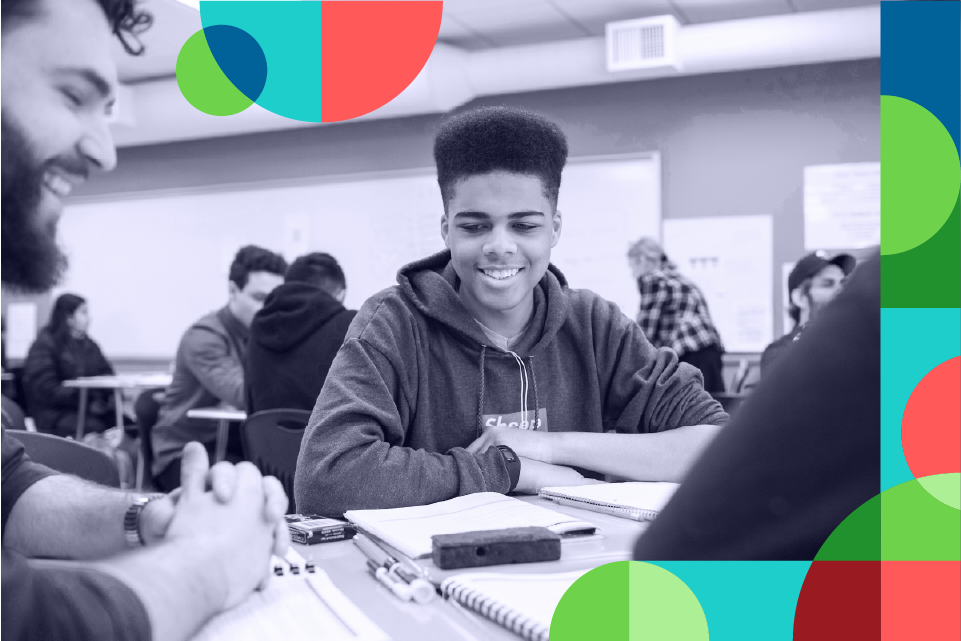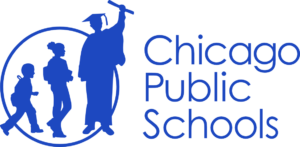Expanding High-Impact Tutoring
in Chicago Public Schools


Chicago Public Schools, University of Chicago Education Lab, & Saga Education
Chicago, Illinois
2012-Present
Executive Summary
This case study explores broad-scale, high-impact tutoring (HIT) programs operated by Saga’s school system partners. Through interviews with program managers, we examine success factors and challenges. Saga supports districts with planning, launching, and implementing high-quality tutoring.
Key Takeaways
- High-impact tutoring significantly improves student learning – University of Chicago Education Lab research showed that Chicago Public School students who participated in Saga Education tutoring gained 1 to 2.5 years of learning compared to students who did not participate in tutoring.
- The tutoring model’s success and sustainability were bolstered by Title I federal funds and federal ESSER funds to address pandemic-related learning interruptions.
- CPS, the Education Lab, and Saga’s long-term partnership laid the foundation for a scalable expansion of the high-impact tutoring more broadly through the district.
The Challenge
In 2011, Chicago Public Schools (CPS) faced high levels of youth violence and a widening achievement gap. CPS and the University of Chicago Crime Lab and Education Lab identified a group-based counseling program that addressed youth violence and increased students’ engagement in school but had no effect on test scores. They sought academic interventions to complement the counseling program and enhance learning opportunities for students.
They identified high-impact tutoring as a promising, evidence-based intervention to support students. High-impact tutoring (HIT) involves small groups of students (typically fewer than 4 students) working with a well-trained tutor during the school day. Students meet with tutors for at least 30 to 60 minutes a day for 10-36 weeks. They identified Saga Education’s predecessor, Match Education, as a potential partner in implementing this type of intensive tutoring, and, in partnership with Chicago Public Schools, ran a pilot in 2012 in Harper High School that expanded to a larger effort with Saga in 2014 and beyond.
Promising Pilot Study Spurs Partnership
The Education Lab worked with the City of Chicago, CPS, and the nonprofit Saga Education (then operating as Match Education) to conduct a pilot study on HIT in Harper High School on the South Side of Chicago. After promising results from the initial 2012 pilot at Harper High School run by John Wolf of the University of Chicago Education Lab, CPS formed a long-term partnership with Saga Education, where tutoring was expanded to 12 district schools in 2014, then 15, then several dozen. Meanwhile, the Education Lab, together with CPS and Saga, conducted two large-scale randomized, controlled trials with thousands of students in the city. The Education Lab’s research from 2013-15 found that Chicago students who participated in high-impact tutoring by Saga Education™️ for one school year gained 1 to 2.5 years of additional learning compared with students who did not participate in tutoring.
“Given positive results, CPS and the Mayor’s Office figured out how they could use some of their Title I funding and invest in high-impact tutoring, so tutoring could become sustainable,” said Monica Bhatt, Senior Research Director, The University of Chicago Education Lab.
Delivering High-impact Tutoring During the School Day
CPS used those findings to help expand HIT to other schools. Through Saga Education’s direct program – a turnkey service – Saga hires and supervises tutors through a partnership with AmeriCorps. Saga provides roughly three weeks of pre-service training to tutors, also called “fellows.” Fellows receive ongoing, weekly professional development during their service year, and frequent in-service coaching by a Saga staff supervisor on site. Using Saga’s math curriculum aligned with classroom instruction, Saga fellows deliver HIT during the school day as a separate, for-credit class period. Depending on the school, students receive tutoring via several different models: in-person or with a live-online tutor.
A Saga-employed site director supervises fellows and, where fellows deliver remote tutoring sessions, is also available in the classroom to help facilitate student learning and address technical issues. Saga tutors and students who participate in live-online tutoring use Saga Connect, a platform developed by Saga to host interactive math tutoring sessions.
“I really like working with my tutor,” said Rihanna, a CPS high school student. “[My tutor] is very helpful and pushes you harder and makes sure you aren’t afraid to say the answer.”
To date, Saga Education (together with the work of its predecessor Match Education) has delivered the resources needed to improve Algebra I grades to over 19,000 students across 43 schools within the district through the tutoring efforts of 1,100 Saga Fellows (and 30,000 students nationwide).
Solutions-Oriented Research for Education
Saga, the Education Lab, and CPS have partnered on several randomized controlled trials to understand the effectiveness of high-impact tutoring on student learning. The Education Lab, together with CPS and Saga, conducted studies looking at a variety of program model designs; in-person and blended tutoring models, and models using 2:1, 3:1 and 4:1 student-to-tutor ratios.
Bhatt said that the partnership between the Education Lab and Saga is different from a traditional research approach of studying and commenting on trends in the schools. “Ours is a very solutions-oriented approach where we’re rolling up our sleeves and trying to figure out not just the effects of a program, but how to change that intervention design to be more effective,” she said. “By doing so we aren’t just passively commenting on the status quo, but trying to partner in figuring out what will work in the long term.” Bhatt noted that although district leaders consider HIT cost-effective, they consider it cost-prohibitive to scale more widely. Recent research has been aimed at identifying ways to maintain learning results while reducing costs.
Pandemic’s Impact Fuels Scaling of High-impact Tutoring
CPS’ experience with HIT put them in a strong position to address COVID-related learning loss recovery.
“Because we had been working so closely with CPS and Saga since 2012 to bring high-impact tutoring to the district, when the pandemic hit, high-impact tutoring was one of the first things the district expressed interest in scaling up using ESSER (Elementary and Secondary School Emergency Relief fund) dollars,” Bhatt said.
CPS launched a new program, the Tutor Corps, creating one of the nation’s largest in-house tutoring programs. In 2024, CPS Tutor Corps employed around 600 part-time tutors in 229 schools, and at least 10,000 students received at least one tutoring session in the last year.
“We found that remote learning [during the pandemic] was ineffective for a lot of students,” said Ellen Kim, program manager for CPS Tutor Corps. “Those students who were most heavily impacted were those on the south and west sides of Chicago, neighborhoods with limited resources. That was one of the reasons why CPS started the Tutor Corps.”
Training, Communication, and Flexibility Aid Scaling of High-impact Tutoring
Kim said that the implementation of Tutor Corps was “the opposite of gradual. It was immediate.” This created a challenge of communicating to schools about the tutors and their roles within schools. “Clear, consistent, and responsive communication is vital,” she said. “We had to reiterate through communications with schools, with the tutors, with multiple stakeholders, what tutors’ roles were and how they fit into the school ecosystem.”
Saga supports CPS with the implementation of its Tutor Corps for high-impact math tutoring. Saga provides the training, coaching, and curriculum to support CPS. During the 2023-24 school year, in addition to offering Saga’s direct tutoring program in 27 schools, Saga helped Chicago Public Schools implement HIT in an additional 116 schools. “Saga has been highly involved in how we train and support our part-time Tutor Corps math site leads,” Kim said. Saga staff meet weekly or biweekly to help train them on best practices for supporting tutors.
Saga Education aims to scale our high-impact tutoring framework by growing our Saga Consult program—through which we help schools, districts, and states implement their own tutoring programs by providing technical assistance, quality assurance, and technology resources—nationally as a solution to accelerate educational equity for our target student population. This will enable us to serve the country and move the needle for underserved students with an education intervention that has proven impact and results.
In CPS, either the school administrator or the school-level lead for Tutor Corps (a role that schools assign to a full-time employee) determines how tutoring is implemented. Kim has seen schools use a variety of approaches to implementing HIT in schools including using an intervention block for tutoring, integrating tutors into classrooms, and pulling students out of class for tutoring.
“When students came back to high school after being gone for a couple years, or home for a couple years, we saw some academic struggles. As a high school principal, I noticed it more on a socio-emotional level, in that it was difficult for some students to express themselves, to feel comfortable and safe at school, to feel like they belonged and have a sense of belonging and ownership,” said Emily Feltes, principal of CPS’ North-Grand High School. “Based on last year’s results from Tutor Corps, I am thrilled and excited about this year. I’m looking forward to seeing our students succeed and thrive in their math classes.”
‘Doubling Down’ on Tutoring Puts Students on Path to Recovery
According to CPS, when compared to other large urban districts in the Council of Great City Schools, CPS students outpaced the state of Illinois as a whole and were in the top third among large urban districts in terms of gains in math from 2019-2023. Black and Latinx students also ranked in the top third among large urban districts for growth in math from 2019-2023. CPS’ Chief Education Officer Bogdana Chkoumbova, in a 2024 interview with WTTW News, partially attributed the recovery to the district “doubling down” on investments in hiring interventionists, tutors, and instructional coaches.
CPS is now participating in the Personalized Learning Initiative (PLI), a multi-year study led by the University of Chicago Education Lab and nonprofit MDRC to better understand how to scale the benefits of tutoring, including continuing to strengthen the implementation of Tutor Corps and understand its impacts on student learning. Saga serves as the technical assistance partner for the PLI, assisting districts by providing its playbook for high-impact tutoring.
The Education Lab is also examining Saga’s tutoring models in CPS, including a blended model that combines face-to-face tutoring and computer-assisted learning to reduce cost while preserving learning outcomes. The long-term partnership between the Education Lab, Saga Education, and CPS has highlighted the effectiveness of tutoring and provided a model to scale the framework of HIT and to identify and disseminate best practices.
“We hear positive feedback from schools that they like their tutors, and students feel more confident in their [math] work,” Kim said. “We’re starting to see the amount of learning students have gained through our work putting students in a better position.”
